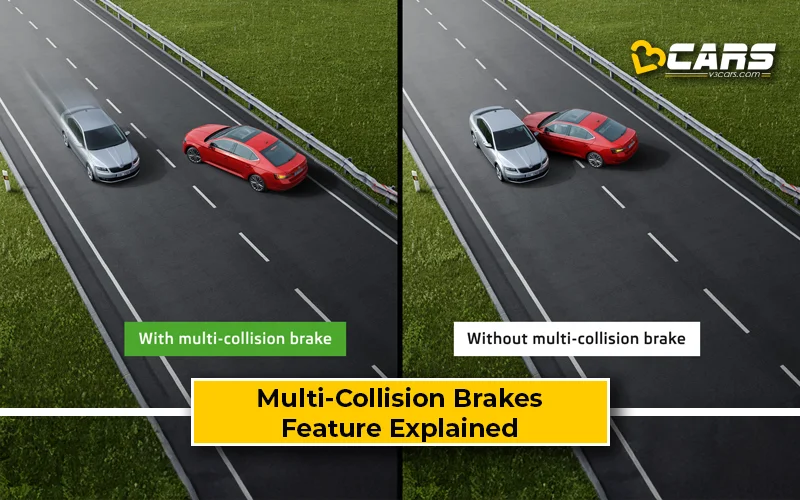Multi-Collision Brakes – Feature Explained
While modern cars are equipped with numerous safety features designed to prevent a collision or protect occupants during an initial impact, the danger doesn’t always end there. After a primary crash, a car might still move due to momentum, potentially leading to secondary collisions with other vehicles, roadside objects, or even pedestrians. This is where multi-collision brakes (also known as Post-Collision Braking System or Secondary Collision Brake) come into play – a vital car safety technology designed to mitigate the risks of these subsequent impacts.

What Are Multi-Collision Brakes?
Multi-collision brakes are an advanced safety system that automatically applies the vehicle’s brakes after an initial collision has occurred. The system’s primary goal is to reduce the vehicle’s speed and bring it to a controlled stop, thereby preventing or reducing the severity of any subsequent impacts. This feature is particularly vital because, after a severe primary collision, the driver might be incapacitated or unable to react, and the vehicle’s existing safety systems (like airbags) may have already deployed.
How Do Multi-Collision Brakes Work?
The operation of multi-collision brakes is seamlessly integrated with the car’s existing safety systems:
- Impact Detection: The system is typically triggered by sensors that detect a primary collision, most commonly when the airbags are deployed. This indicates a significant impact has occurred.
- Signal to ESC/Braking System: Once a primary collision is detected, information is immediately sent to the vehicle’s electronic stability control (ESC) system and the braking system.
- Automatic Braking: If the braking system is sufficiently intact to function safely, the multi-collision brake system autonomously applies the brakes. The vehicle is automatically slowed down at a controlled rate to a very low speed or a complete stop.
- Vehicle Stability: During braking, the system works in conjunction with other driving stability systems like ABS (anti-lock braking system) and ESC to help keep the vehicle stable and in its lane, preventing uncontrolled skidding.
- Warning Signals: The hazard lights and brake lights light up during and after the braking process to warn other road users of the incident.
- Driver Override: Crucially, the driver can usually override the multi-collision brake system at any time by depressing the accelerator pedal. This allows the driver to regain control if, for example, stopping the vehicle immediately would create a greater hazard .
- Deactivation Conditions: The system will deactivate if the accelerator pedal is depressed beyond a certain level, the vehicle comes to a complete stop, or if there’s a malfunction in the ESC or other electronic systems.
What Are The Pros And Cons Of Multi-Collision Brakes?
Here are the pros, or advantages, of multi-collision brakes:
- Prevents Secondary Collisions: This is the primary and most significant benefit. By automatically stopping the vehicle, it drastically reduces the likelihood of subsequent impacts, which are often highly injurious as primary safety systems may already be compromised.
- Enhanced Passenger Safety: Helps protect occupants from additional injuries by limiting further uncontrolled movement of the vehicle after the initial crash.
- Reduced Vehicle Damage: By bringing the vehicle to a controlled stop, it can minimise further damage to the car’s structure and components, potentially lowering repair costs.
- Improved Road Safety: Contributes to overall road safety by reducing the risk of multi-car pile-ups, especially in high-speed or congested traffic scenarios.
- Autonomous Action: Acts independently when the driver might be unable to, providing a critical layer of safety in chaotic post-collision moments.
Here are the cons, or disadvantages, of multi-collision brakes:
- System Limitations: If the vehicle’s braking system is severely damaged in the initial impact, the multi-collision brake may not operate effectively.
- Cost: As an advanced safety feature, it adds to the overall cost and complexity of the vehicle.
Can Multi-Collision Brakes be installed from the aftermarket?
No, installing multi-collision brakes from the aftermarket is not feasible. This system is a deeply integrated part of a vehicle’s core safety architecture, relying on communication with airbag sensors, the electronic stability control (ESC) unit, and the braking system. It requires complex calibration and is designed as an integral component of the vehicle’s original safety design. Attempting to retrofit such a system would be extremely difficult, prohibitively expensive, and could severely compromise the vehicle’s overall safety and crashworthiness.
Affordable Cars In India That Offer Multi-Collision Brakes?
Multi-collision brakes are increasingly becoming a standard safety feature, particularly in models that have achieved high safety ratings (like 5-star Euro NCAP or Bharat NCAP ratings). While initially found in premium and luxury cars, this technology is now trickling down into more accessible segments in India, often as part of a comprehensive safety package.
You can find this feature in the following cars:
- Skoda Kylaq
- Skoda Slavia
- Skoda Kushaq
- Volkswagen Virtus
- Volkswagen Taigun
Also Read: Digital IRVM - Feature Explained
Helpful Tools:
- Fuel Cost Calculator for Cars – Know your monthly fuel expense based on usage and mileage
- Car On-Road Price Calculator – Convert ex-showroom to on-road price for any city
Sell Used Car Online – Enter your car and contact details to get an instant price estimate and book a free inspection with our partner network


0 Comments